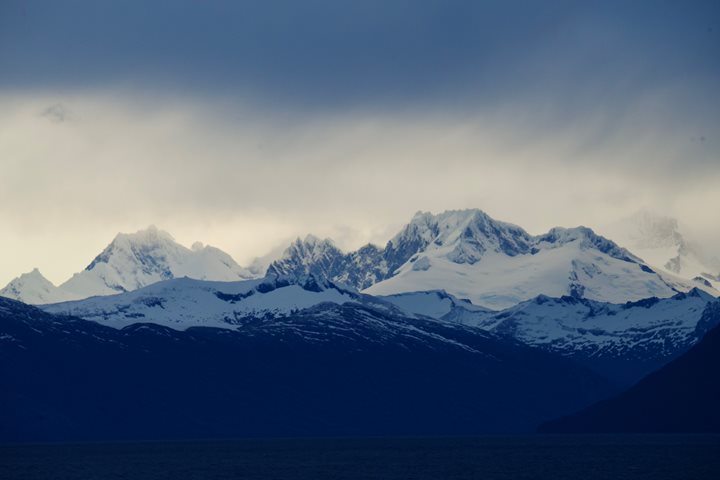We were already well inside of Seno Montañas (Fjord of Montains) as the night sky gave way to daybreak, and by 0630 the surrounding peaks still capped in winter's snow revealed themselves. It was quite blustery and steady rain began to shower the decks and windows of the bridge, conditions not uncommon for this part of the world. As an Alaskan I'm quite familiar with an old saying often used, “If you don't like the weather wait ten minutes or walk a mile.” Those words were never more applicable than here in Patagonia and the Chilean Fjords. If one were to look up Patagonia or Chilean fjords in a photo dictionary the pictures from this morning's outing would certainly be worth 1,000 words.
Moments before we were set to disembark, three staff members, expedition leader Lucho Verdisoto, Santiago Imberti, and myself set out in a scout boat. Sure it was a little windy and a little rainy but we were surrounded by amazing scenery and just ahead in plain sight was the Bernal Glacier, so weather be damned it was going to be a beautiful day. Just as we approached the shore a full rainbow arced across the sky over the landing sight like a cosmic welcome sign. Soon scores of rain-gear-clad explorers set out to get a taste of Patagonia firsthand. Once ashore the plan was simple; stroll down the gravel trail through the dwarf Nothofagus forest, along the glacial lagoon, atop the gravely moraine, and smack dab to the face of the Bernal Glacier. Soon there were breaks in the rain, and occasional moments of direct light shown down on the glaciers icy-blue face while the clouds whisked around the peaks giving this setting a dynamic and magical feeling. There are very few places that one can literally walk up to the face of a glacier and by the end of the morning nearly all that went ashore found themselves in awe at the spectacle of the landscape shaping and rock crushing ice.
In order to reach our next destination, Puerto Natales, we have to, or should I say we get to navigate through the spectacular fjord Canal Santa Maria and ultimately through the fabled Angostura White, or White Narrows, an aptly named passage at the northern end of Canal Santa Maria. When making such a transit it is crucial to time the passage with the appropriate tidal conditions, ideally a slack tidal state. With the narrowest portion of the narrows just a mere couple of ship widths in breadth with an added challenge of a starboard banking turn for added dramatic effect we prepared to make this a successful and thrilling passage. First we set two Zodiacs in the water, one to monitor the direction and speed of the tidal currents and another, driven by this author, with the “film crew” to capture this thrilling navigation. The wind speeds were upwards approaching 20 knots with standing tidal waves of two meters in the open channel. Around the narrows proper and the rocky forested islets the currents were ripping through and swirling madly at places. By this time the bridge, bow, and top deck were filled with excited guests anticipating the passage. In about 15 minutes the scout boat reported to the bridge that the currents were approaching slack conditions, so the command was given and our Captain and crew brought our fine ship through Angostura White in style. As she exited two adult Andean condors and several rock cormorants welcomed her through the narrows.
The remainder of the afternoon was spent cruising out into Gulfo Almirant Montt on our approach to Puerto Natales. It was a lovely afternoon on the bow to admire the landscape, seabirds, windblown seas, and reflecting on all that Patagonia has shown us.









